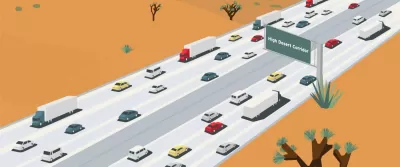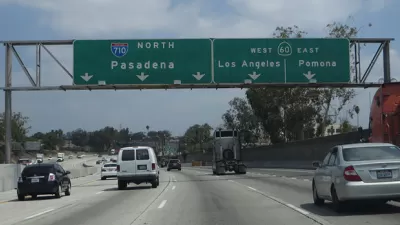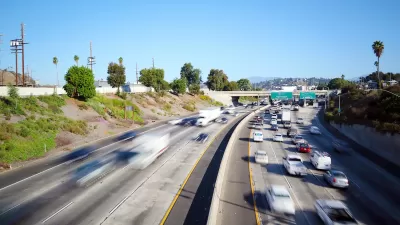What could have been the first new freeway for Los Angeles County in decades might now only mark the end of an era.

"A recent court settlement spells the end for the planned High Desert Corridor Freeway," reports Joe Linton from Southern California.
The High Desert Corridor would have been an $8 billion, 63-mile freeway spanning two counties—Los Angeles and San Bernardino. "In 2016, Caltrans certified the project’s Environmental Impact Report (EIR). The plan was for a High Desert 'multi-purpose corridor' featuring an 8-10 lane freeway, plus bike path, solar panels, and high-speed rail," according to Linton. The project was also lined up for nearly $2 billion in funding from Measure M, the L.A. County transportation sales tax approved by voters in 2016.
As explained by Linton, the project's EIR provoked a lawsuit from environmental groups, challenging the project on terms set by both state and federal environmental regulations. A judge sided with the plaintiffs, finding that the EIR was insufficient in measuring biological and greenhouse gas impacts. Instead of drafting a supplemental EIR, Caltrans has decided to shelve the project, reports Linton.
Frontier Group and U.S. PIRG earlier this year named the project as one of the nation's worst highway boondoggles, and now that the project is dead, the Los Angeles Times Editorial Board has taken a firm stance in opposition to the idea. The editorial raises one salient question that continues to plague land use and transportation planners in the state of California: Why is a state committed to reducing emissions and continuing to allow so much development in far-flung, exurban communities? The Trump administration has even begun to exploit the state's hypocrisy.
FULL STORY: Caltrans Settles Environment Lawsuit, Cancels High Desert Freeway Project

Planetizen Federal Action Tracker
A weekly monitor of how Trump’s orders and actions are impacting planners and planning in America.

Congressman Proposes Bill to Rename DC Metro “Trump Train”
The Make Autorail Great Again Act would withhold federal funding to the system until the Washington Metropolitan Area Transit Authority (WMATA), rebrands as the Washington Metropolitan Authority for Greater Access (WMAGA).

DARTSpace Platform Streamlines Dallas TOD Application Process
The Dallas transit agency hopes a shorter permitting timeline will boost transit-oriented development around rail stations.

Renters Now Outnumber Homeowners in Over 200 US Suburbs
High housing costs in city centers and the new-found flexibility offered by remote work are pushing more renters to suburban areas.

The Tiny, Adorable $7,000 Car Turning Japan Onto EVs
The single seat Mibot charges from a regular plug as quickly as an iPad, and is about half the price of an average EV.

Supreme Court Ruling in Pipeline Case Guts Federal Environmental Law
The decision limits the scope of a federal law that mandates extensive environmental impact reviews of energy, infrastructure, and transportation projects.
Urban Design for Planners 1: Software Tools
This six-course series explores essential urban design concepts using open source software and equips planners with the tools they need to participate fully in the urban design process.
Planning for Universal Design
Learn the tools for implementing Universal Design in planning regulations.
Municipality of Princeton
Roanoke Valley-Alleghany Regional Commission
City of Mt Shasta
City of Camden Redevelopment Agency
City of Astoria
Transportation Research & Education Center (TREC) at Portland State University
US High Speed Rail Association
City of Camden Redevelopment Agency
Municipality of Princeton (NJ)





























